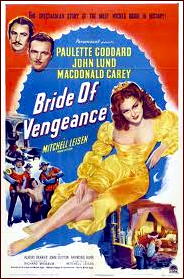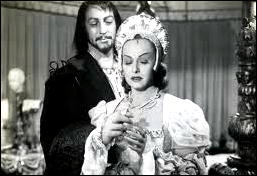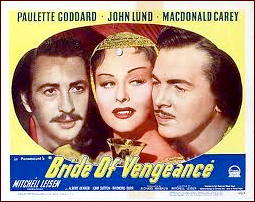Sun 27 Jan 2013
A Movie Review by Dan Stumpf: BRIDE OF VENGEANCE (1949).
Posted by Steve under Films: Drama/Romance , Reviews[4] Comments
BRIDE OF VENGEANCE. Paramount, 1949. Paulette Goddard, John Lund, Macdonald Carey, Albert Dekker, John Sutton, Raymond Burr. Director: Mitchell Leisen.

BRIDE OF VENGEANCE sounds like one of those syrupy, echt-Hollywood projects: an economy-minded trip to Renaissance Italy via the studio backlot, peopled with American actors like Paulette Goddard and Macdonald Carey as the Borgia siblings, wrapped around a simplified “historical†story that serves mainly as an excuse for lavish costumes and sets — done in black-and-white as if to signify that Paramount had little interest in the project to start with — how surprising, then, that this emerges as an intelligent, even beautiful bit of work.
Some of the credit has to go to writers Michael Hogan (who adapted REBECCA to the screen as faithfully as possible) and Clemence Dane (author of A BILL OF DIVORCEMENT) and to cinematographer Daniel Fapp (he went on to WEST SIDE STORY) who provides baroque deep-focus imagery reminiscent of Olivier’s HAMLET. There are also some evocative (if cheap) sets offered up by Paramount’s art department. But the true beauty of this film seems to come from director Mitchell Leisen.

Mitchell Leisen was never a major auteur of The Cinemah, but he maintained a highly satisfying output over the years, with favorites like HOLD BACK THE DAWN, GOLDEN EARRINGS and especially the morbidly balletic DEATH TAKES A HOLIDAY. All of them are done with an almost painterly eye for composition and mise-en-scene, like a classical landscape from the Pre-Raphaelites.
For BRIDE he provides an intriguing visual style that seems to define the characters; most of them (including John Lund as an Italian prince!) sport a colorful renaissance look, bright, vivid andperhaps a bit effeminate. In contrast, the Borgias and their entourage all have a vaguely medieval look: throw-backs to a more primitive time, capable of all sorts of nastiness, mostly done for them by Raymond Burr, typecast as usual in those days as a heavy in every sense of the word. The scene where he consoles Lucretia on the death of her latest husband (engineered by himself) without a trace of irony is one of the high points of his career in villainy.

But getting back to director Leisen, he infuses each scene with a clear-eyed romanticism that simply dazzles the eye and moves the plot (such as it is) along quite nicely. There’s a wonderful bit about Prince Lund dabbling in the arts, trying to cast a statue of Jupiter, followed by a baroque tracking shot down into the stygian bowels of his foundry where we discover what “Jupiter†really is as the music pounds to a crescendo worthy of BRIDE OF FRANKENSTEIN.
There are other moments too. Moments that lift the tawdry story and suffuse it with a lovingly artistic moodiness. Enough of them to make BRIDE OF VENGEANCE something memorable. And definitely worth seeing.
February 2nd, 2013 at 12:27 am
Dan, I understand it conceivable that a someone might relate to Bride of Vengeance, and you are that person some sixty years after production. Mitchell Leisen had an outstanding career up until this point. But, a combination of changing tastes and personal problems impacted his ability to maintain his previous success. By the way, of course it looks good. Leisen was a designer of considerable taste and ability.
Upon release of this film, Paulette Goddard was finished, as a big time film star. Verify this by checking her resume. John Lund and MacDonald Carey were both on the way out at Paramount. Lund fulfilled his contract with at least one good noir, No Man Of Her Own, and joined Carey at Universal where they played leads in less important projects. Carey was more successful on television and Lund was playing tertiary parts within five years. High Society a notable example.
Raymond Burr had almost nothing to do with it. Just an actor for hire in a supporting part. He and Albert Dekker remained employable.
When this thing was given the green light there must have been memories of the Joe Sternberg Marlene Dietrich collaborations. The talent for that kind of filming was not present.
February 2nd, 2013 at 12:52 am
Re The Black and White issue. Color was reserved for musicals and some, not all, westerns. To put it in perspective, Clark Gable’s only color film was Gone With The Wind through 1951 and Across The Wide Missouri. Cary Grant appeared in Night And Day. That’s it until the fifties. Black and White continued to be the go to mode for years after depending upon the project’s conception. Some Like It Hot. The Misfits. The Defiant Ones. Judgment at Nuremberg. No one should interpret filming in black and white as anything more than artistic decision. Years later, we add Schindler’s List to our list.
February 2nd, 2013 at 12:33 pm
About Color, well, maybe…..
While Color was mostly for musicals, it was also featured in many late-40s Westerns, Easterns (Arabian Nights movies) and Fox made it a staple of their Ty Power swashbucklers. So much so that when they made PRINCE OF FOXES in B&W, Power saw the handwriting on the screen and went independent.
I still maintain that BRIDE OF VENGEANCE is an uncommonly fine film, and I shall wait for fashion and critical consensus to catch up with me.
February 2nd, 2013 at 1:14 pm
Dan:
Everyone went independent in that period. At Universal they continued trying a while longer…but the hand writing wasn’t because Prince of Foxes was shot in black and white. At Fox years later Zaauck produced The Longest Day. Not a small film by any standard. In b & w. As far as opinion re Bride, that is personal taste. I’ve no problem with that but with the analysis.